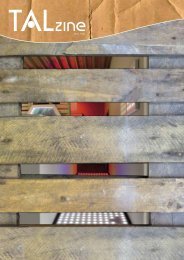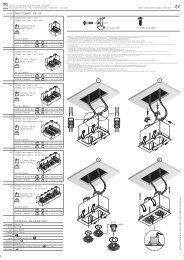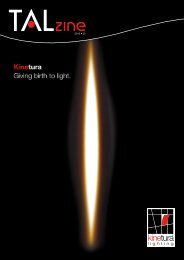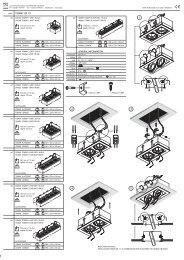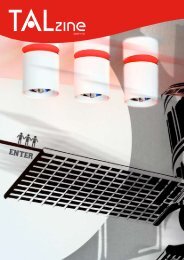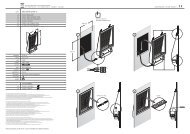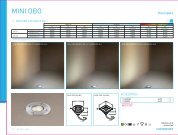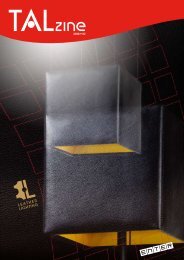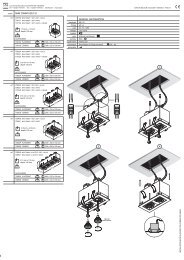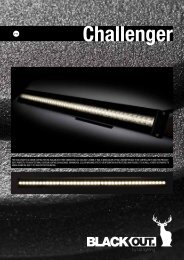Create successful ePaper yourself
Turn your PDF publications into a flip-book with our unique Google optimized e-Paper software.
with a maximal difference of 4 %. The trend line is in<br />
accordance with Mikheyev’s regression: the maximal<br />
difference <strong>be</strong>tween both is 5 %. To verify the metal foam<br />
height’s influence for the 10 PPI metal foam, measurements<br />
have <strong>be</strong>en performed for five different metal foam heights.<br />
The metal foam height’s influence on the heat transfer is<br />
clearly distinguishable. As the metal foam height increases,<br />
the heat transfer improves. The increase is affected by raising<br />
Rayleigh num<strong>be</strong>rs. The increase however diminishes as the<br />
metal foam height increases. Comparing the measurements<br />
for different metal foam heights to the results obtained for a<br />
flat surface, one notices that the latter curve is flatter. Finally<br />
the obtained results are compared to the trend line obtained<br />
by Phanikumar et al. Extrapolating the Nusselt num<strong>be</strong>r as a<br />
power function of metal foam height using the test results,<br />
one <strong>be</strong>comes the values as expected using Phanikumar’s trend<br />
line.<br />
To verify the influence of the metal foam height for the 20 PPI<br />
metal foam, measurements have <strong>be</strong>en performed for three<br />
different heights. The metal foam height’s effect is clearly<br />
visible. The convection coefficient and the corresponding<br />
Nusselt num<strong>be</strong>r increase as the metal foam height increases.<br />
The increase is affected by raising Rayleigh num<strong>be</strong>rs.<br />
Figure 1 measurements 20 PPI sample, different foam heights<br />
The conclusion is valid for all trend lines. Moreover Nusselt<br />
num<strong>be</strong>r augments as the metal foam height increases.<br />
Finally the results are compared with the Phanikumar’s and<br />
Hetseroni’s trend lines. Surprisingly the heat transfer for<br />
Hetseroni’s 10 mm trend line is higher than the heat transfer<br />
measured at a metal foam height of 12 mm. This can <strong>be</strong><br />
explained by the fact that in Hetseroni’s experiments the foam<br />
was not attached to the base plate, it was clamped on both<br />
sides instead . The sample was heated by sending a current<br />
through the metal foam. Therefore the transferred power<br />
was distributed more uniform over the metal foam, moreover<br />
the air could move more freely through the metal foam.<br />
Phanikumar’s trend line corresponds very well to the obtained<br />
test results.<br />
33<br />
2012 • 01<br />
Figure 2 measurements brazed test sample vs epoxy glued<br />
The metal foam can <strong>be</strong> connected to the base plate in<br />
different ways, two of these are investigated in this work: the<br />
first is called ‘brazing the metal foam to the base plate’, while<br />
the second one is called ‘gluing the metal foam to the base<br />
plate using epoxy glue’. The average improvement obtained<br />
by brazing is around 11 % Finally Bhattacharya’s trend line<br />
is compared to the obtained results. The trend line almost<br />
depicts the same increase as does the 12 mm epoxy glued<br />
metal foam trend line.<br />
The influence of the pore density has also <strong>be</strong>en examined. For<br />
each metal foam height the heat transfer is less in the 20 PPI<br />
metal foam. On average the Nusselt num<strong>be</strong>r increases with<br />
about 20 % using the 10 PPI metal foam in comparison with<br />
the 20 PPI metal foam.<br />
The two metal foam types have also <strong>be</strong>en compared to a<br />
classical heatsink with a height of 18 mm. One can conclude<br />
that at identical metal foam height 10 PPI metal foam causes<br />
the greatest heat transfer, while the classical heatsink causes<br />
the smallest heat transfer. In the 4,000 – 6,000 interval of<br />
Rayleigh num<strong>be</strong>rs, 10 PPI metal foam gives rise to Nusselt<br />
num<strong>be</strong>rs that are on average 70 % higher than those<br />
corresponding to a classical heatsink. For 20 PPI metal<br />
foam the effect diminishes to about 45 %.<br />
In order to verify the influence of the box’s geometry,<br />
18 experiments have <strong>be</strong>en conducted. To perform these<br />
experiments, metal foam height, box width, box height and<br />
base plate temperature have <strong>be</strong>en varied.<br />
The obtained regression equation was:<br />
© Robin Reynders



